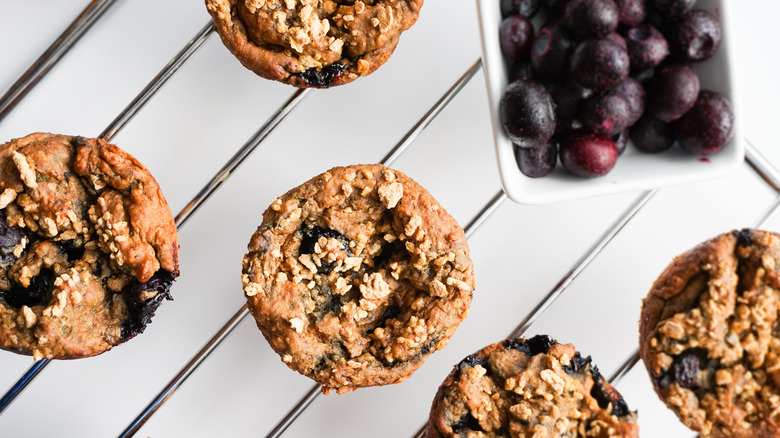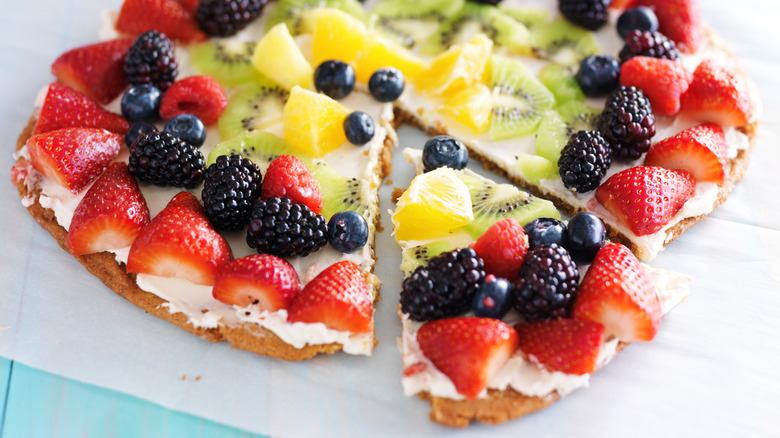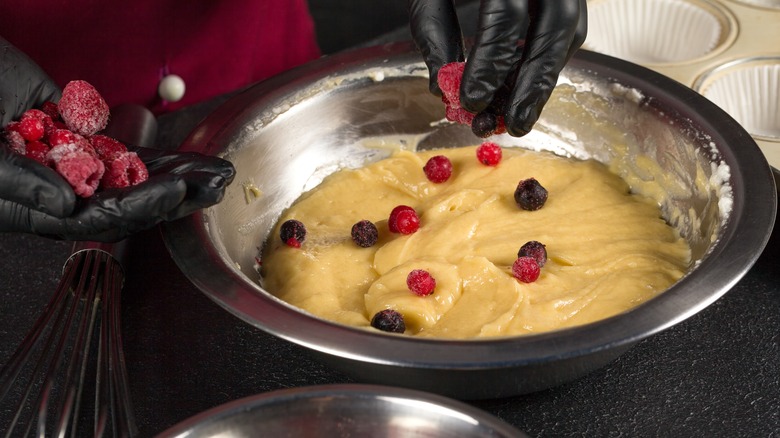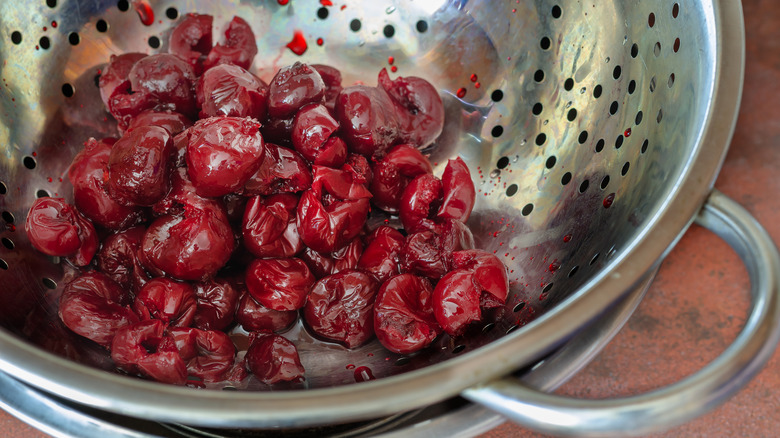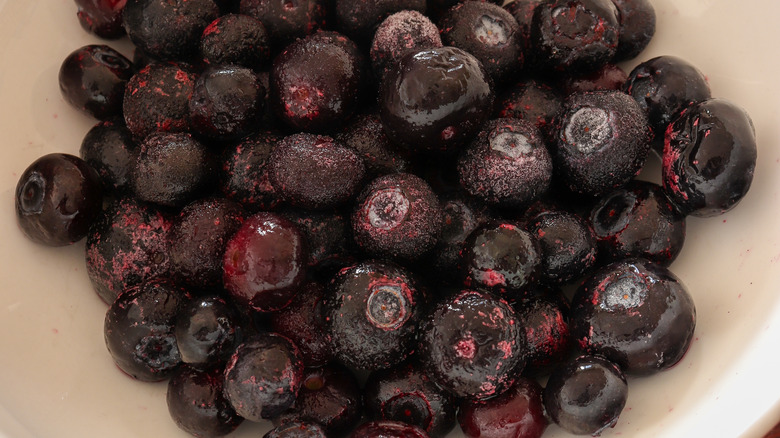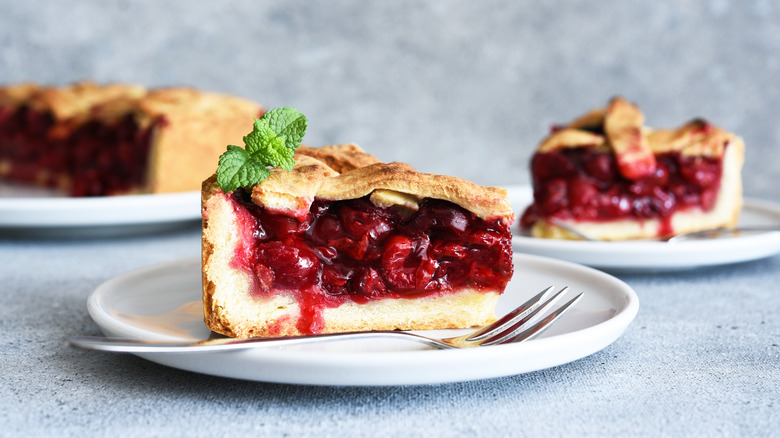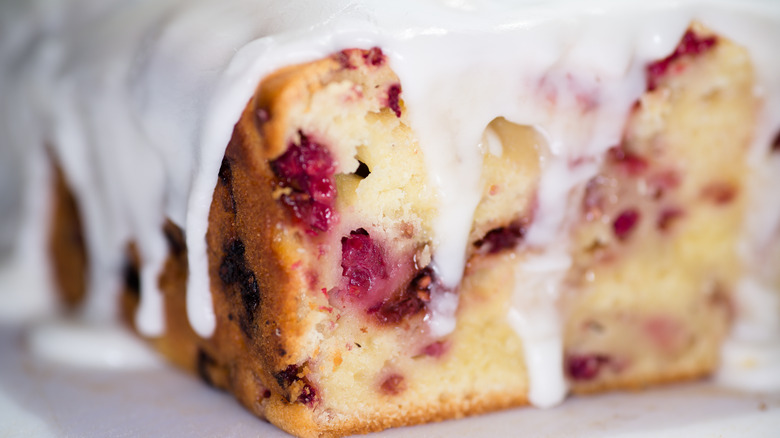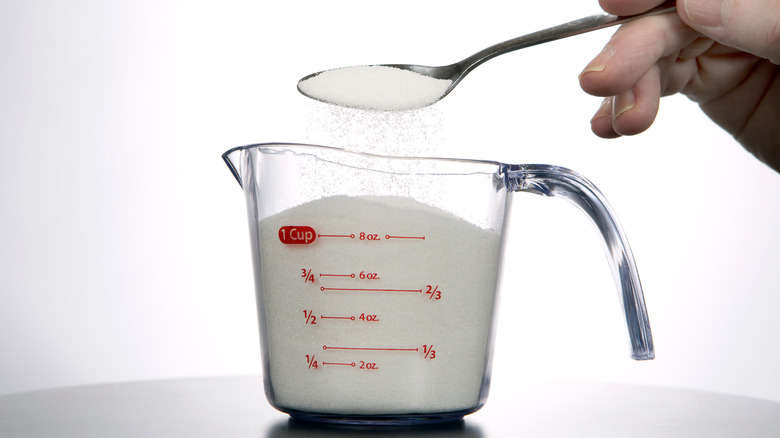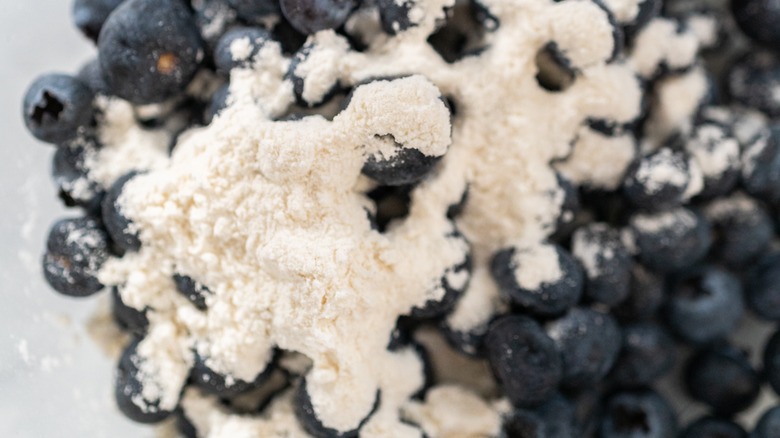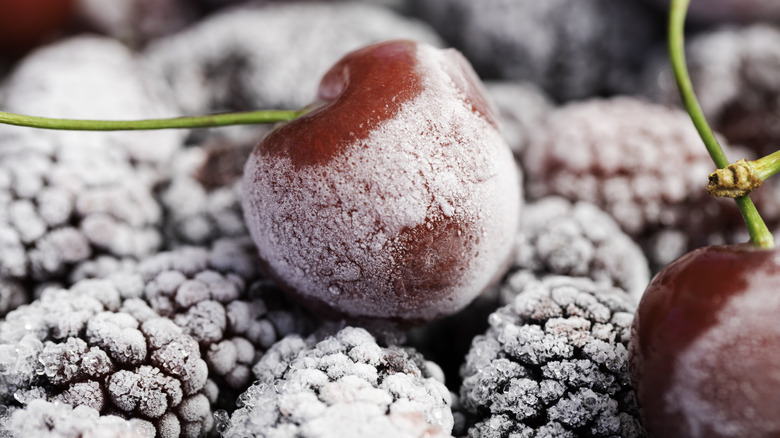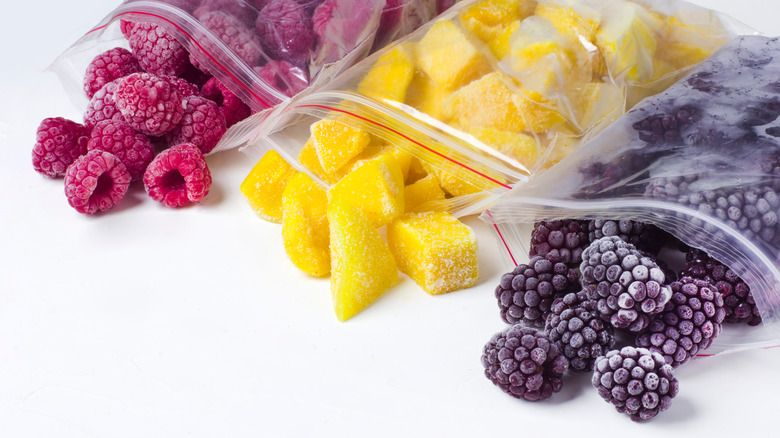Mistakes Everyone Makes When Baking With Frozen Fruit
If the treats you make with frozen fruit aren't turning out as you hoped, you may be making some elementary mistakes. Perhaps you spent raspberry season carefully picking red jewels from a thorny patch in the backyard, freezing extras as you dreamed of a scrumptious raspberry pie. Finally, just before summer ended, you retrieved the amount of fruit you needed for the recipe. The crust came together perfectly. Then, you added the raspberries and stuck the masterpiece in the oven. Everything looked great, but the finished pie wasn't what you had imagined. The filling was too mushy and sour, and the crust drooped from too much moisture. It was a complete and utter disaster — no one wanted to eat it.
If that describes your experience baking with frozen fruit, don't worry. Here, you'll find tips from a variety of experts to take your frozen fruit baking up a notch. Professional chefs, a registered dietitian, and the founder of a frozen food company weigh in on how to get the best outcome from this ingredient. Follow their advice and you're sure to get better results from your frozen produce by the time the next harvest rolls around.
Thinking you can always sub frozen fruit for fresh
Frozen fruit is a star at adding flavor and color, but texture and beauty are not its strengths. Before jumping headlong into a baking project that calls for fresh fruit which you are replacing with frozen, evaluate the importance of the sensation of having that ingredient in your mouth. Does the success of the recipe depend on an element of crunch? Do people go into fits of happiness when their teeth puncture a whole berry and it explodes in their mouth? Is fresh fruit key to decorating the top of your pastry? If so, skip using frozen fruit as a substitute because it can only disappoint. Chef Melissa Baker of FoodQueries says, "It's best to avoid using frozen fruit where the texture and appearance are crucial."
In other words, you may love fruit pizza so much that you want to eat it year-round, even when berries aren't in season. Unfortunately, you won't enjoy the dessert as much or even at all if you use frozen berries instead of fresh ones. The delightful sensation of biting into a sugar cookie topped with crisp fruit will disappear if you decorate the top with thawed, mushy gunk. As a general rule, if you're going to cook or bake a recipe after adding frozen fruit, you can use it as a substitute. On the other hand, if the recipe usually calls for raw fruit, skip using frozen alternatives to retain the appropriate consistency.
Using the wrong frozen fruit in the wrong recipe
Some frozen fruits may go perfectly in one dish but ruin others — knowing which recipes to make with a specific fruit is vital. First, think about how the fruit responds to freezing. Some, like bananas and peaches, turn to mush. Don't use them in recipes where the fruit needs to maintain its shape. On the other hand, delicate fruits — raspberries, blackberries, and blueberries — hold together better frozen, especially when you mix them into batter. Once you bake them they may disintegrate, while simultaneously creating heavenly little pockets of flavor in your muffins and pancakes.
Registered dietitian and Michigan State University food safety educator Kara Lynch recommends against using frozen fruit in pies — especially peaches. She says, "Peaches do tend to break down some and can get mushy, so they may be better in something that doesn't require a plump fruit structure, for example, a glaze for a cheesecake."
Chef Steven Hernandez, who received his title from the Institute of Culinary Education, says, "Frozen fruits shine in cobblers, smoothies, and quick breads." Meanwhile, BBQ expert Jakob Miller adds, "Think of classics like blueberry muffins, raspberry scones, or mixed berry pies. The intense cold can help these fruits retain their shape and flavor during baking, resulting in bursts of fruity goodness in every bite. "
Forgetting to account for moisture content
Freezing fruit releases trapped moisture, so once it thaws the fruit loses its shape and the excess liquid drains out. That makes baking with this ingredient difficult since some recipes turn out soggy, especially if you haven't made accommodations for the extra liquid. Additionally, there are some moisture-sensitive dishes you'll simply want to steer clear of.
Mark Coe, a founder of Farm to Freezer, says, "When fruit is frozen the cells burst so fruits tend to be very soft." Chef Steven Hernandez suggests, "Keep fruit frozen for dishes like smoothies and muffins, where excess water won't ruin the texture," and adds, "Skip frozen fruit in jams and jellies, where the moisture content needs to be precise." Jakob Miller comments, "I'd avoid using frozen fruit in recipes that require a delicate touch, such as fruit tarts or custard-based desserts. The extra moisture can throw off the balance, leaving you with a less-than-ideal result."
Deal with the extra moisture before it becomes a problem. Thawing the fruit in a colander and letting it drain is one course of action. Sometimes, you don't even need to wait for it to melt completely — Miller gets great results by leaving the fruit for 30 minutes at room temperature before patting it down with a paper towel. You can also coat frozen berries with flour or cornstarch to absorb the excess liquid as the fruit bakes.
Skipping the thaw
Frozen fruit seems like such a practical solution — it's already chopped and cleaned. It's tempting to simply pour it into the batter as is, without waiting for it to thaw. If you do, you may be making a big mistake, though. Thawing is a fundamental step in some recipes and skipping it could cause the finished product to fail in a number of ways.
RD Kara Lynch warns, "Depending on the product, your cooking time may take longer," and adds that this can result in "a product with uneven doneness." She has a great point. If you've ever eaten a muffin that seems a little raw right around the fruit bits, the baker may have used unthawed frozen fruit. That causes the treat to bake more quickly in some parts and less so in others.
Using thawed versus unthawed frozen fruit changes the texture of a dish as well. Think about a banana bread recipe. Lynch notes, "Bananas should be thawed before baking as they are typically mashed, I usually also drain off the liquid that seeps from the thawed bananas. Frozen bananas do produce a great moist baked product." No one wants to find a huge chunk of banana in their banana bread, and first draining off the excess liquid is the perfect way to account for extra moisture.
Always thawing frozen fruit
There are some cases where you can use frozen fruit directly and skip the thawing step. Generally, unthawed frozen fruit offers top results in recipes that stay in the oven for a longer amount of time. For example, pies take about an hour whereas muffins need around 25 minutes. So, you might choose to use unthawed frozen fruit in a pie, but not muffins. As a dish bakes over a longer period, the fruit slowly thaws and some of the excess liquid evaporates from the dish. That can prevent the final product from being too moist.
Chris Watson, CEO of EatForLonger, says, "If you are making a pie or a tart, leave the fruit frozen and add it directly. This will keep the crust from becoming soggy. Frozen fruit is best used in recipes that require a longer baking time." Watson's advice makes sense. Think about the way a pie bakes; the crust browns before the fruit has completely softened and released its liquid. That means your pie will have a juicy, goopy filling with a crisp crust — just the way you like it.
Over mixing frozen fruit into the batter
If you've ever made raspberry muffins, you know how hard it is to keep the pieces of fresh fruit whole. That's a great reason to freeze these berries a few hours before getting started. Once they're hard, they're easier to fold into the dough without getting crushed. Of course, you still shouldn't overdo it with the stirring.
Julie Morris, founder of Julie's Family Kitchen, says, "When incorporating frozen fruit, gently fold it into the batter to prevent it from breaking apart and coloring the entire dish." This is especially true of brightly colored berries like raspberries, blueberries, and blackberries. If you don't want your quick bread tinged pink or purple throughout, you'll have to delicately mix these fruits into the batter. If you're making muffins, you may find it easier to pour the batter into the muffin tin and then distribute the berries evenly into each one.
Forgetting to adjust the baking time
Baking with frozen fruit, especially if it's unthawed, means you'll have to be extra careful about the amount of time you cook the recipe. The fruit can cause the dish to chill throughout, meaning it takes longer to bake. It's not easy to judge exactly how much colder a dish is or how much time to add to the timer as a consequence.
Melissa Baker has some easy ways to deal with this uncertainty. First, she advises to watch the dish extra carefully as it bakes. In other words, if you were planning on sticking a cake with frozen pineapple chunks in the oven and leaving it there while you vacuum the house, forget about it. If you're baking with frozen fruit, you'll need to be especially vigilant so that your creation doesn't burn or end up with raw spots interspersed throughout. Dedicate your full attention to the baking process. Baker also recommends using the toothpick test. Stick a knife, toothpick, or other thin object into the middle of the dish. If it comes out clean then it's done, but if some of the batter sticks bake it for a while longer.
Messing up the amount of sugar
Freezing fruit makes it less sweet and flavorful so some bakers adjust by adding more sugar, according to Julie Morris. They may be making a mistake, though. Adding too much sugar can cause serious repercussions on the quality of the final product — your dessert may become too soggy to fully enjoy. In fact, Mark Coe says he usually tries to reduce the amount of sugar he uses when baking with frozen fruit.
Cooks need to be careful with sugar because it produces a chemical reaction that impacts much more than just flavor. For example, macerating fruit is a process of softening by soaking, often in sugar. This works because the sugar releases liquid from the fruit by osmosis. That, in turn, decreases the pressure in the fruit and makes it softer, which is particularly useful when you're using fresh fruit that is not at peak ripeness.
Freezing already draws out moisture from the fruit, so if you add too much sugar to the mix, it simply becomes liquid goop. Chef Steven Hernandez explains that "Overcompensating for the lack of sweetness in frozen fruits by adding extra sugar can throw off the moisture balance." This doesn't mean bakers should forego sugar altogether, though. That will also negatively affect the texture. Rather, if you're having trouble with a particular frozen fruit recipe turning out too moist, try reducing the quantity of sugar and adjusting based on the results.
Forgetting to coat fruit in flour
If you're dumping frozen fruit into your mixing bowl without coating it in flour or cornstarch first, that's a blunder. According to Jakob Miller, skipping this step is one of the most serious mistakes bakers can make. He adds, "This simple trick can save your baked goods from becoming a watery mess." As the fruit thaws during baking, it releases moisture. Having a dry powdery substance around it soaks up some of the juices that inevitably burst out.
There's a second reason to toss berries in flour, as well. If your recipe has a thin batter, you may have noticed that the fruit usually sinks to the bottom. That uneven distribution probably won't change the taste of the dessert, but it's not very pleasing to the eye. Adding a little flour to the outside of the berries will keep them suspended in the flour. Don't exaggerate though; just use a tablespoon or so of flour to toss the berries. Then, make sure to subtract that quantity from the total amount of flour you use in the recipe so your batter doesn't end up being too dry.
Using low-quality frozen fruit
Not all frozen fruit is created equal — if you're using produce that's less than the best, it may negatively impact the flavor of your final creation. Check the ingredient label at the supermarket first. Julie Morris recommends skipping products with added sugar and preservatives because "This ensures a better flavor profile in your baked goods."
For example, Walmart's Great Value brand offers frozen fruit at fantastic prices — a pound of a mixed blend with strawberries, peaches, mango, and pineapple costs under $3. Look at the label, though, and you'll see it contains ascorbic and citric acid, which could change the flavor of your baking. Check out the label on the brand's organic blueberries, though, and you'll note that blueberries are the only ingredient present.
Finally, it's important to remember frozen fruit will not maintain a top quality forever. If you come across a bag of cherries in your freezer and can't remember when you put them there, you may want to check they are still good before adding them to your next baking project. Follow Kara Lynch's instructions on how to spot frozen fruit that's past its due date: "If fruit has a lot of ice crystals on it or spots that appear dry or damaged, it may not make you ill, but the poor quality will result in a less desirable product." In other words, you may be best off throwing out the bag of cherries and buying a new one.
Only using store-bought frozen fruit for baking
Sometimes we forget about the fantastic opportunity freezers provide. Yes, it's easiest to pick up a bag of fruit from the grocery store freezer aisle, but you could be missing out. Freezing should be about preserving excess fruit when it's in peak condition. For example, nothing quite compares to eating fresh peaches from a local farm — they're sweet and juicy but only available for a few weeks a year. If you have a surplus over a short period, it makes sense to freeze the excess. Why not buy a couple of bushels, eat what you can, and freeze the rest? They'll add more flavor to your cooking than what you'll find at the supermarket in the off-season.
"Preserving fruit by freezing is a great way to enjoy fruit throughout the year, and baking is just one way to utilize frozen fruit," according to Lynch. Since she's from Michigan, she has some great tips for preserving blueberries. First, don't wash them before freezing since that can make the skin tough. Spread them out on a tray in the freezer and store them in Ziplock bags once they're hard. Then, give them a quick wash before adding them to your recipe to wash away the dirt as well as juices that could stain your quick bread purple throughout. Of course, the fruit that defines your region may differ, so choose something local and research the best ways to preserve that particular fruit.
